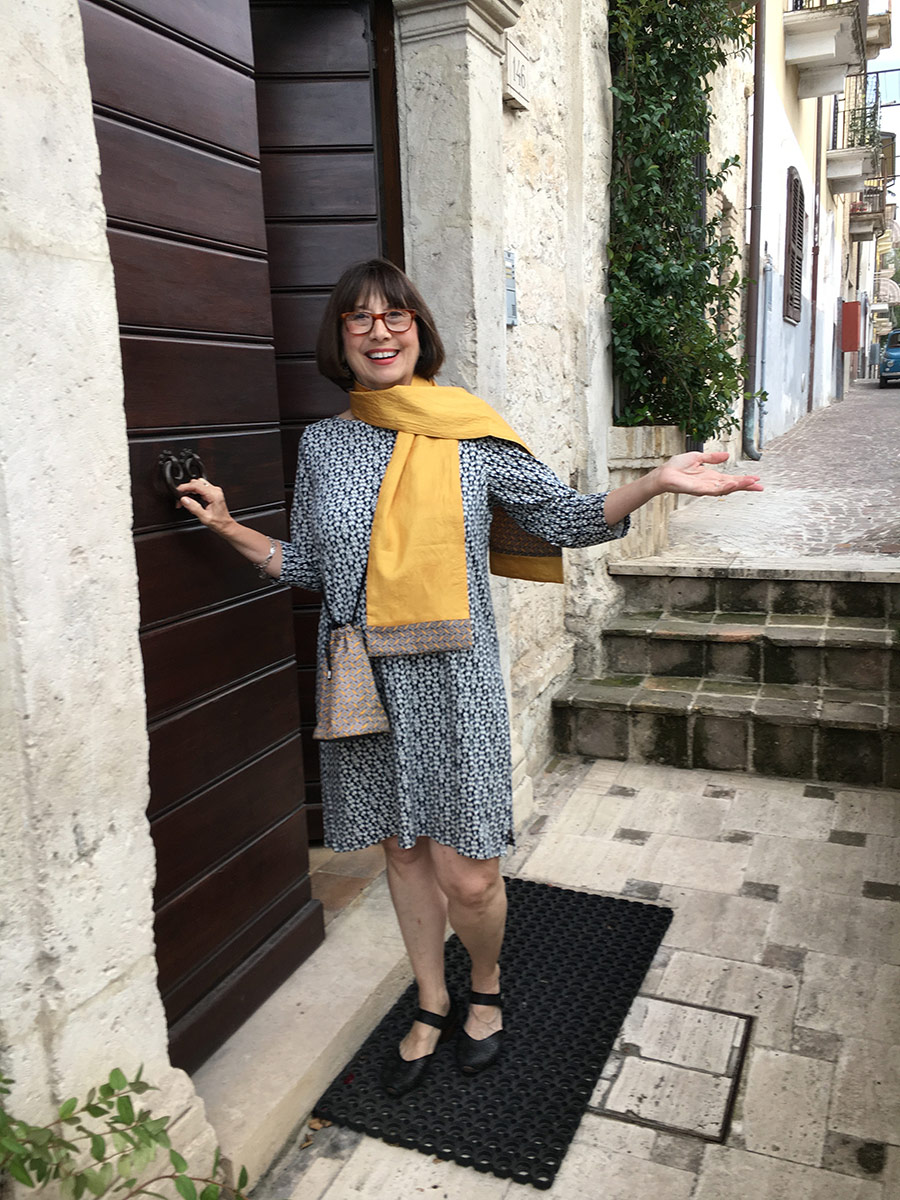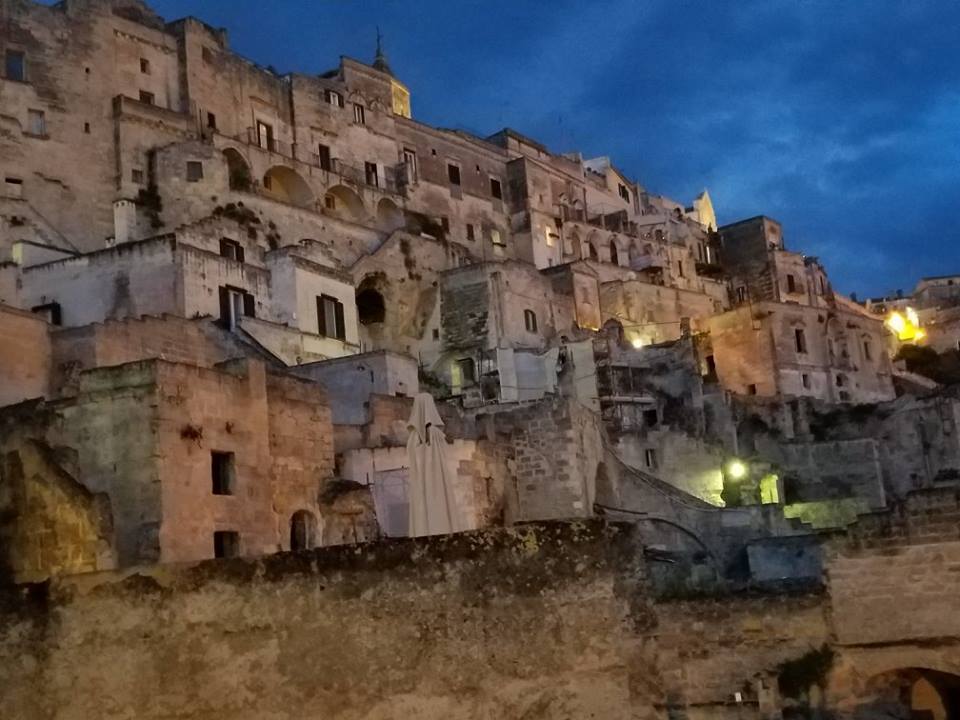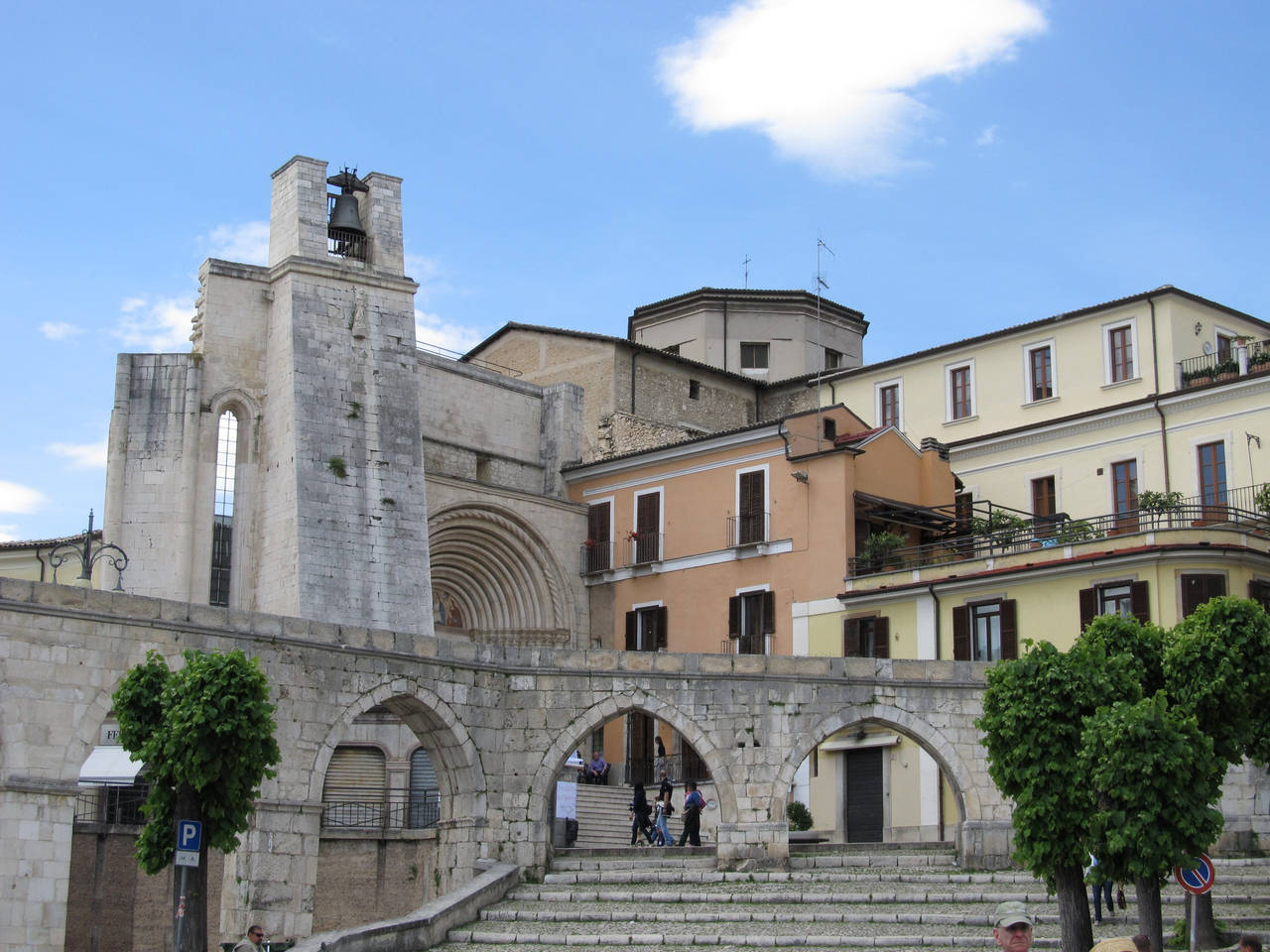Sulmo mihi patria est. — Ovid
We began our 2011 Italian adventure by creeping out of Rome’s Fiumicino airport and into a major traffic jam — the usual — but only after having our perfunctory rental car adventure. I guess Italian tourists travel with bags the size of fanny packs, because our mid-sized car that we made clear was to hold four passengers for two weeks virtually collapsed after the first bag was launched into the trunk. After a fair amount of wrangling, we were upgraded to a larger car that still barely held the bags, but hold them it did, and we were off, into the aforementioned traffic jam. About 90 minutes and 10 km later, we discovered that there had been a very minor fender bender, which was handled in a typically Italian way: gobs of officials standing around, a cute little portable sign blocking one lane out of the airport, an ambulance (unused, as far as we could tell) and hundreds of infuriated Italians and frustrated tourists rubbernecking around the scene in their cars. Let the good times begin!
 We took the autostrada east into the region of Abruzzo, about a two-hour drive, and headed for the historic city of Sulmona, which was to be our home for four nights. Sulmona is a dynamic town of some 25,000 residents located in the center of Abruzzo among the highest peaks of the Appenines. The views from Piazza Garibaldi, the main square and home of July’s famed Palio, are breathtaking. Mists and snow were frequent on the mountaintops, and when the sun came out, it was spectacular. Close to several ski areas — Roccaraso being the one everybody raves about — and not too far from the beaches of Pescara along the Adriatic, Sulmona offers visitors a great jumping off point for drives and recreation of all kinds. Problem, is there aren’t too many visitors. At least not Americans. German and Dutch visitors have found the place, for sure, but we need to bring up the averages, people — this place is great!
We took the autostrada east into the region of Abruzzo, about a two-hour drive, and headed for the historic city of Sulmona, which was to be our home for four nights. Sulmona is a dynamic town of some 25,000 residents located in the center of Abruzzo among the highest peaks of the Appenines. The views from Piazza Garibaldi, the main square and home of July’s famed Palio, are breathtaking. Mists and snow were frequent on the mountaintops, and when the sun came out, it was spectacular. Close to several ski areas — Roccaraso being the one everybody raves about — and not too far from the beaches of Pescara along the Adriatic, Sulmona offers visitors a great jumping off point for drives and recreation of all kinds. Problem, is there aren’t too many visitors. At least not Americans. German and Dutch visitors have found the place, for sure, but we need to bring up the averages, people — this place is great!
Sulmona was home to the poet Ovid, whose presence is felt everywhere in the city, from his statue in Piazza XX Settembre to his famed saying, “Sulmo mihi patria est” (Sulmona is my fatherland) written out or abbreviated SMPE all over town. Sulmona was also a very important artisan and commercial town back in the day and it’s hard to walk a block without seeing a statue or monument of some grace and import. But the tough economy has hit here, too. We were told about a 60% unemployment rate among the city’s youth, for starters. And on our walk around town, we were shown a significant patch of land, maybe 40 feet by 15 feet, under which lay some apparently well-preserved Roman or Byzantine mosaics. The city has carefully covered them up and grassed them over for safekeeping and will restore and reveal them when it has the money to do so properly.
Settembre to his famed saying, “Sulmo mihi patria est” (Sulmona is my fatherland) written out or abbreviated SMPE all over town. Sulmona was also a very important artisan and commercial town back in the day and it’s hard to walk a block without seeing a statue or monument of some grace and import. But the tough economy has hit here, too. We were told about a 60% unemployment rate among the city’s youth, for starters. And on our walk around town, we were shown a significant patch of land, maybe 40 feet by 15 feet, under which lay some apparently well-preserved Roman or Byzantine mosaics. The city has carefully covered them up and grassed them over for safekeeping and will restore and reveal them when it has the money to do so properly.
Our B&B was just off P. Garibaldi, right at the end of a 13th century aqueduct. In fact, one of the arches of the aqueduct actually ran through our bedroom! Sei Stelle offers comfortable accommodations right in the heart of the city. It was a fine jumping off point for our walking tour of the city and frequent trips to shops, restaurants and the local mercato. Run by the Frattaroli family (originally from Sulmona and who now split their time between Sulmona and Boston, where they run the Filippo Ristorante in Boston’s North End), Sei Stelle is an affordable option offering a fine continental breakfast every morning and the option for you to negotiate with the caretaker, cousin Franca, to cook for you (and it’s fantastic). But do be aware that little or no English is spoken here and that with my little or no Italian, we did run into a few glitches. Nothing that couldn’t be solved, but it could have gotten sticky.
 So now that we’re here in the middle of the Appenines, in this lovely old city, what do we do? Well, first we get a tour. Francesco met us at 9:30 after a first good night’s sleep, and toured us around until lunchtime. We started at the Cathedral of San Panfilo (Sulmona’s patron saint) which is ancient, and which was heavily damaged in an earthquake in 1706. Centuries of rebuilding have lead to an interesting mix of styles, largely Romanesque but with plenty of frescos and wooden, marble and stone artifacts to keep you guessing. The newest part even has a fresco of Pope Benedict XVI in bright colors over the doorway! Of particular interest was the display of artifacts and information about the short-lived Pope Clemente II, who served for only one year and who was, perhaps, a bit too reform-minded for the church at that time. Very near our B&B was the Fountain of the Old Man (La Fontana del Vecchio) and of course, the Acquedotto Medievale (Medieval Aqueduct), built in 1256 under the Swabian ruler Manfredi.
So now that we’re here in the middle of the Appenines, in this lovely old city, what do we do? Well, first we get a tour. Francesco met us at 9:30 after a first good night’s sleep, and toured us around until lunchtime. We started at the Cathedral of San Panfilo (Sulmona’s patron saint) which is ancient, and which was heavily damaged in an earthquake in 1706. Centuries of rebuilding have lead to an interesting mix of styles, largely Romanesque but with plenty of frescos and wooden, marble and stone artifacts to keep you guessing. The newest part even has a fresco of Pope Benedict XVI in bright colors over the doorway! Of particular interest was the display of artifacts and information about the short-lived Pope Clemente II, who served for only one year and who was, perhaps, a bit too reform-minded for the church at that time. Very near our B&B was the Fountain of the Old Man (La Fontana del Vecchio) and of course, the Acquedotto Medievale (Medieval Aqueduct), built in 1256 under the Swabian ruler Manfredi.
But perhaps more than anything, Sulmona is known as the home of confetti. What’s confetti? Ever been to an Italian wedding? Ever gotten a favor of coated white almonds in a little net bag? That’s the American tradition. In Italy, you can get almonds in different colors for all kinds of events, presented in everything from satin bags to Ginori china. White is for weddings and communions; green is for engagement; silver is for 25th anniversaries; red is for graduation and birthdays . . . and so on. At the Pelino headquarters — one of the oldest confetti manufacturers — we saw the Pelino family members carefully taking orders, arranging boxes of colorful creations or managing the small shop. There is also a museum over the factory that displays all manner of machinery, documents and copperware that have to do with the celebrated tradition. And there are confetti stores all around town selling everything from bagged almonds to stunning almond flowers to unusual almond rosaries.
Italian wedding? Ever gotten a favor of coated white almonds in a little net bag? That’s the American tradition. In Italy, you can get almonds in different colors for all kinds of events, presented in everything from satin bags to Ginori china. White is for weddings and communions; green is for engagement; silver is for 25th anniversaries; red is for graduation and birthdays . . . and so on. At the Pelino headquarters — one of the oldest confetti manufacturers — we saw the Pelino family members carefully taking orders, arranging boxes of colorful creations or managing the small shop. There is also a museum over the factory that displays all manner of machinery, documents and copperware that have to do with the celebrated tradition. And there are confetti stores all around town selling everything from bagged almonds to stunning almond flowers to unusual almond rosaries.
We had 12 people on this leg of our journey, one of them whose family hailed from Abruzzo. Vicky’s Mom was from a town called Castel di Sangro, not far from Sulmona; her father was from Pescara on the coast. At a pre-trip dinner, Mario Scalzi (president of Parker Villas) told Vicky that she could count on the Abruzzese to pick her out. He was right: the first day in Sulmona, a woman came up and asked Vicky where her family was from! One rainy day, a group went to help Vicky find her ancestral home. No one in the family had been able to get there successfully, since infrastructure was slow coming to many parts of Abruzzo. In fact, the highways didn’t go into some places until the 1970s. Anyway, this time, Castel di Sangro was reached and, as Vicky was talking on the phone to her mother in Cleveland to tell her the news, the church bells rang. Magic.
 The Abruzzese people were very friendly to us. Lots of smiles and nods, and some were curious enough to ask us where we were from. All in all, it was a delightful place to be. And one day, when we decided to visit the Celestine Abbey in Badia (Santo Spirito al Marrone) to learn about the hermitage tradition, we met a woman who not only gave us a guided tour of the place, but also met up with us later that evening in Sulmona. Novelia is an Abruzzese charmer who lived for several years in Canada and then came back to Sulmona. She and her sister Vittoria are a high- spirited couple of Italians who love where they live and want to show others why they should love it, too. Next time, we’ll consider staying at her place in town, La Casa del Cuore. Drinks at the Hotel Santa Croce Ovidius were a hoot.
The Abruzzese people were very friendly to us. Lots of smiles and nods, and some were curious enough to ask us where we were from. All in all, it was a delightful place to be. And one day, when we decided to visit the Celestine Abbey in Badia (Santo Spirito al Marrone) to learn about the hermitage tradition, we met a woman who not only gave us a guided tour of the place, but also met up with us later that evening in Sulmona. Novelia is an Abruzzese charmer who lived for several years in Canada and then came back to Sulmona. She and her sister Vittoria are a high- spirited couple of Italians who love where they live and want to show others why they should love it, too. Next time, we’ll consider staying at her place in town, La Casa del Cuore. Drinks at the Hotel Santa Croce Ovidius were a hoot.
We passed our four days here in a flurry of wine tours (Valle Reale, whose Montepulciano d’Abruzzo and Trebbiano wines were first-rate), good food and visits to a few neighboring towns like Scanno and L’Acquila. For lunch one day, we drove up to an agriturismo at what seemed like the top of the world to a real find called BioAgriturismo Valle Scannese. We were fed and feted well and they told us tales of snow falling on the piazza in town just the day before. On the way there, we saw shepherds with their flocks of sheep and big white working dogs. We even saw a small cluster of wild boar (cinghiale). This is rugged country, folks, and the real thing.
Tim fell in love with the mountains and the herbal amaro, a local digestivo, and I fell in love with the local rossa (rosé) wine called Cerasuolo. On market day, Tim and I bought a delicious round Romano cheese from a white-haired lady sitting all alone at a small glass display case that she probably hauls around from town to town. We felt a little sorry for her and bought from her instead of from the larger trailer stalls. Then, on the way home, we re-watched The American and saw that George Clooney did the same thing . . . some of the final scenes were shot right there on the piazza. If you’ve seen the movie, you might remember the Easter procession scene — Sulmona is famous for its five-day over-the-top Holy Week celebrations. I can’t wait to come back some day to see it!
Sulmona is a beautiful city with a long history, great traditions and terrific food and wines. I miss it already — especially the church bells ringing all night long, every 15 minutes, reminding me how much sleep I’m missing. But really, I do — there was something comforting about it. There was so much more that we could have done — go to the coast, for instance — but there wasn’t enough time. Just when we were getting used to the pace we had to pack up and go on to the next destination. And that is a story for another day. But put Abruzzo on your list, by all means. It’s a different kind of Italy and you’ve got to see it.
Buon viaggio!

Linda Dini Jenkins is a card-carrying Italophile, travel planner, freelance writer, and amateur photographer. Travel is her passion, so writing about her travels just comes naturally. She hopes all her travelers find a way to express their joys, surprises, and fears as they travel and gives every traveler a nifty journal to help smooth the way. Learn more…


